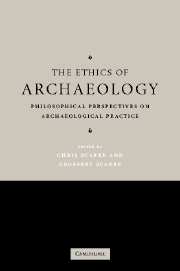Book contents
- Frontmatter
- Contents
- List of contributors
- Acknowledgements
- 1 Introduction
- PART I THE OWNERSHIP OF CULTURAL OBJECTS
- PART II ARCHAEOLOGISTS AND THE LIVING
- 6 Human subjects review and archaeology: a view from Indian country
- 7 Trust and archaeological practice: towards a framework of Virtue Ethics
- 8 Truthfulness and ‘inclusion’ in archaeology
- 9 Ethics and Native American reburials: a philosopher's view of two decades of NAGPRA
- 10 Stewardship gone astray? Ethics and the SAA
- PART III ARCHAEOLOGISTS AND THE DEAD
- PART IV THE COMMON HERITAGE OF HUMANKIND?
- References
- Index
8 - Truthfulness and ‘inclusion’ in archaeology
Published online by Cambridge University Press: 05 June 2012
- Frontmatter
- Contents
- List of contributors
- Acknowledgements
- 1 Introduction
- PART I THE OWNERSHIP OF CULTURAL OBJECTS
- PART II ARCHAEOLOGISTS AND THE LIVING
- 6 Human subjects review and archaeology: a view from Indian country
- 7 Trust and archaeological practice: towards a framework of Virtue Ethics
- 8 Truthfulness and ‘inclusion’ in archaeology
- 9 Ethics and Native American reburials: a philosopher's view of two decades of NAGPRA
- 10 Stewardship gone astray? Ethics and the SAA
- PART III ARCHAEOLOGISTS AND THE DEAD
- PART IV THE COMMON HERITAGE OF HUMANKIND?
- References
- Index
Summary
‘EPISTEMIC INCLUSION’ AND TRUTHFULNESS
A striking feature of archaeology in recent years has been its increasingly ‘inclusive’ character. By ‘inclusion’, here, I mean the bringing into various archaeological activities – from fieldwork to the dissemination of results – of persons or groups outside the circle of trained, professional archaeologists. One thinks, for example, of the increased participation of indigenous peoples in determining the fate of remains, human or artefactual. There are several factors that explain the policy of, and calls for, inclusion. These embrace broadly political and ideological ones – ‘post colonial guilt’ over insensitive intrusions by earlier European archaeologists, say, or a sense that various relevant ‘voices’ have been illegitimately ‘marginalised’ in the past. They include as well a larger perception of the remit of the discipline of archaeology itself. With the emergence of ‘public’, ‘applied’ and ‘ideational’ archaeology, the activities of its practitioners are bound to have a greater bearing than in the past upon matters apt to engage the interests and emotions of people outside the discipline – upon, for example, issues of ‘social transformation’ and ‘social critique’ (Politis 2002: 193) or the validity of traditional belief systems. A related factor has been a heightened perception of the importance of archaeology to and for people outside of the profession, an appreciation of the potential of archaeological findings and interpretations to arouse powerful, conflicting feelings in large numbers of people.
- Type
- Chapter
- Information
- The Ethics of ArchaeologyPhilosophical Perspectives on Archaeological Practice, pp. 131 - 145Publisher: Cambridge University PressPrint publication year: 2006
- 15
- Cited by

